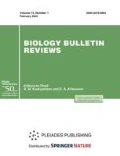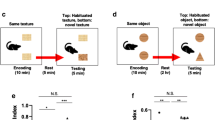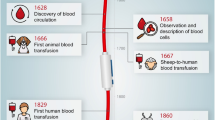Abstract
The issues of increasing life span and significant improvement in its quality are relevant for modern gerontology. The review discusses one of the proposed methods to slow the aging of an organism via the transfusion of blood or plasma from young people to senile ones. Information on the structure, properties, and functions of TIMP-2, MANF, and irisin protein growth factors, which are contained in large amounts in the blood of young organisms, is presented. Experiments on animals showed an increase in their life span and improvement of their cognitive abilities under the effect of these factors. They are of great importance for the enhancement of neurogenesis in the brain, improvement of the cardiovascular and immune system functions, and cancer prevention. The relationship between the high content of irisin in the blood of young organisms and telomere lengthening, its role in eliminating signs of Alzheimer’s disease, mouse modeling, and the elimination of cerebrovascular ischemia were revealed. The administration of umbilical cord blood with a high TIMP-2 content to old mice improves synaptic plasticity and cognitive functions. Further research on the geroprotection effects of blood transfusions from young organisms to aging ones shows promise for the creation of drugs based on these proteins for the treatment of neurodegenerative diseases and cerebrovascular pathology.
Similar content being viewed by others
REFERENCES
Ahlskog, J.E., Does vigorous exercise have a neuroprotective effect in Parkinson disease? Neurology, 2011, vol. 77, pp. 288–294.
Ahn, M.Y., Kim, B.J., Kim, H.J., et al., Anti-cancer effect of dung beetle glycosaminoglycans on melanoma, BMC Cancer, 2019, vol. 19, no. 1, p. 9.
Aicardi, G., Young blood plasma administration to fight Alzheimer’s disease? Rejuvenation Res., 2018, vol. 21, no. 2, pp. 178–181.
Amico, F., Briggs, G., and Balogh, Z.J., Transfused trauma patients have better outcomes when transfused with blood components from young donors, Med. Hypotheses, 2019, vol. 122, pp. 141–146.
Arida, R.M., Cavalheiro, E.A., da Silva, A.C., et al., Physical activity and epilepsy: proven and predicted benefits, Sports Med. (Auckland), 2007, vol. 38, pp. 607–615.
Aronis, K.N., Moreno, M., Polyzos, S.A., et al., Circulating irisin levels and coronary heart disease: association with future acute coronary syndrome and major adverse cardiovascular events, Int. J. Obes. (London), 2015, vol. 1, pp. 156–161.
Asadi, Y., Gorjipour, F., Behrouzifar, S., et al., Irisin peptide protects brain against ischemic injury through reducing apoptosis and enhancing BDNF in a rodent model of stroke, Neurochem. Res., 2018, vol. 43, no. 8, pp. 1549–1560.
Askari, H., Rajani, S.F., Poorebrahim, M., et al., Glance at the therapeutic potential of irisin against diseases involving inflammation, oxidative stress, and apoptosis: an introductory review, Pharmacol. Res., 2018, vol. 129, pp. 44–55.
Assyov, Y., Gateva, A., Tsakova, A., et al., Irisin in the glucose continuum, Exp. Clin. Endocrinol. Diabetes, 2016, vol. 124, no. 1, pp. 22–27.
Aydin, S., Kuloglu, T., Ozercan, M.R., et al., Irisin immunohistochemistry in gastrointestinal system cancers, Biotech. Histochem., 2016, vol. 91, no. 4, pp. 242–250.
Belviranli, M., Okudan, N., Kabak, B., et al., The relationship between brain-derived neurotrophic factor, irisin and cognitive skills of endurance athletes, Physician Sportsmed., 2016, vol. 44, no. 3, pp. 290–296.
Boada, M., Anaya, F., Ortiz, P., et al., Efficacy and safety of plasma exchange with 5% albumin to modify cerebrospinal fluid and plasma amyloid-β concentrations and cognition outcomes in Alzheimer’s disease patients: a multicenter, randomized, controlled clinical trial, J. Alzheimer’s Dis., 2017, vol. 56, no. 1, pp. 129–143.
Bogomolets, A.A., Izbrannye trudy (Selected Research Works), Kiev: Akad. Nauk UkrSSR, 1957, vol. 2, p. 419.
Bonewald, L., Use it or lose it to age: a review of bone and muscle communication, Bone, 2018, vol. 120, pp. 212–218.
Buchman, A.S., Boyle, P.A., Yu, L., et al., Total daily physical activity and the risk of AD and cognitive decline in older adults, Neurology, 2012, vol. 78, pp. 1323–1329.
Büyüktuna, S.A., Doğan, H.O., Bakır, D., et al., Increased irisin concentrations in patients with Crimean-Congo hemorrhagic fever, Jpn. J. Infect. Dis., 2017, vol. 70, no. 5, pp. 475–478.
Castellano, J.M., Fuster, V., Jennings, C., et al., Role of the polypill for secondary prevention in ischemic heart disease, Eur. J. Prev. Cardiol., 2017, vol. 24, no. 3, pp. 44–51. https://doi.org/10.1177/2047487317707324
Chalisova, N.I., Ryzhak, A.P., Lin’kova, N.S., et al., The effect of polypeptides on cell regeneration in a culture of different tissues of young and old rats, Usp. Gerontol., 2015, vol. 28, no. 1, pp. 93–107.
Chazova, I.E., Oshchepkova, E.V., and Zhernakova, Yu.V., Diagnostics and treatment of arterial hypertension, Kardiol. Vestn., 2015, no. 1, pp. 3–30.
Cotman, C.W., Berchtold, N.C., and Christie, L.A., Exercise builds brain health: key roles of growth factor cascades and inflammation, Trends Neurosci., 2007, vol. 30, pp. 464–472.
Danilova, T., Belevich, I., Li, H., et al., MANF is required for the postnatal expansion and maintenance of pancreatic β-cell mass in mice, Diabetes, 2019, vol. 68, no. 1, pp. 66–80.
Davidov, S.O., Kuznik, B.I., Stepanov, A.V., et al., The effect of kinesitherapy on the content of the “hormone of youth” irisin in healthy people and patients with coronary heart disease, Vestn. Vosstanov. Med., 2015, vol. 5, pp. 91–98.
De Meneck, F, Victorino de Souza, L, Oliveira, V., et al., High irisin levels in over weight/obese children and its positive correlation with metabolic profile, blood pressure, and endothelial progenitor cells, Nutr. Metab. Cardiovasc. Dis., 2018, vol. 28, no. 7, pp. 756–764.
Donskov, S.I. and Yagodinskii, V.N., Last days of A.A. Bogdanov: chronicle of tragedy, Vestn. Sluzhby Krovi Ross., 2006, vol. 1, pp. 1–8.
El-Lebedy, D.H., Ibrahim, A.A., and Ashmawy, I.O., Novel adipokines vaspin and irisin as risk biomarkers for cardiovascular diseases in type 2 diabetes mellitus, Diabetes Metab. Syndrome, 2018, vol. 12, no. 5, pp. 643–648.
Emanuele, E., Minoretti, P., Pareja-Galeano, H., et al., Serum irisin levels, precocious myocardial infarction, and healthy exceptional longevity, Am. J. Med., 2014, vol. 127, no. 9, pp. 888–890.
Gannon, N.P., Vaughan, R.A., Garcia-Smith, R., et al., Effects of the exercise-inducible myokine irisin on malignant and non-malignant breast epithelial cell behavior in vitro, Int. J. Cancer, 2015, vol. 136, no. 4, pp. 197–202.
Gizaw, M., Anandakumar, P., and Debela, T.A., Review on the role of irisin in insulin resistance and type 2 diabetes mellitus, J. Pharmacopuncture, 2017, no. 4, pp. 235–242.
Habib, A., Hou, H., Mori, T., et al., Human umbilical cord blood serum-derived alpha-secretase: functional testing in Alzheimer’s disease mouse models, Cell Transplant., 2018, vol. 27, pp. 438–455.
Hayashi, Y., Mikawa, S., Masumoto, K., et al., GDF11 expression in the adult rat central nervous system., J. Chem. Neuroanat., 2018, vol. 89, pp. 21–36.
He, L., He, W.Y., Yang, W.L., et al., Lower serum irisin levels are associated with increased vascular calcification in hemodialysis patients, Kidney Blood Pressure Res., 2018, vol. 43, no. 1, pp. 287–295.
Hernandez-Trejo, M., Garcia-Rivas, G., Torres-Quintanilla, A., et al., Relationship between irisin concentration and serum cytokines in mother and newborn, PLoS One, 2016, vol. 11, no. 11, p. 0165229.
Hisamatsu, T., Miura, K., and Arima, H., Relationship of serum irisin levels to prevalence and progression of coronary artery calcification: a prospective, population-based study, Int. J. Cardiol., 2018, vol. 267, pp. 177–182.
Hofmann, B., Young blood rejuvenates old bodies: a call for reflection when moving from mice to men, Transfus. Med. Hemother., 2018, vol. 45, no. 1, pp. 67–71.
Icli, A., Cure, E., Cumhur Cure, M., et al., Novel myokine: irisin may be an independent predictor for subclinic atherosclerosis in Behçet’s disease, J. Invest. Med., 2016, vol. 64, no. 4, pp. 875–881.
Jeremic, N., Chaturvedi, P., and Tyagi, S.C., Browning of white fat: novel insight into factors, mechanisms, and therapeutics, J. Cell Physiol., 2017, vol. 232, no. 1, pp. 61–68.
Kalkan, A.K., Cakmak, H.A., Erturk, M., et al., Adropin and irisin in patients with cardiac cachexia, Arq. Bras. Cardiol., 2018, vol. 111, no. 1, pp. 39–47.
Keles, E. and Turan, F.F., Evaluation of cord blood irisin levels in term newborns with small gestational age and appropriate gestational age, SpringerPlus, 2016, vol. 5, no. 1, pp. 1757.
Khavinson, V.Kh., Kuznik, B.I., and Ryzhak, G.A., Peptide bioregulators: a new class of geroprotectors, Report 2. The results of clinical trials, Adv. Gerontol., 2014, vol. 4, no. 4, pp. 346–361.
Khavinson, V.Kh., Kuznik, B.I., Tarnovskaya, S.I., et al., Peptides and CCL11 and HMGB1 as molecular markers of aging: literature review and own data, Adv. Gerontol., 2015, vol. 5, no. 3, pp. 133–140.
Khavinson, V.Kh., Kuznik, B.I., Tarnovskaya, S.I., et al., Short peptides and telomere length regulator hormone irisin, Bull. Exp. Biol. Med., 2016a, vol. 160, no. 3, pp. 347–349.
Khavinson, V.Kh., Kuznik, B.I., Tarnovskaya, S.I., et al., GDF11 protein as a geroprotector, Biol. Bull. Rev., 2016b, vol. 6, no. 2, pp. 141–148.
Kim, J.H. and Kim, D.Y., Aquarobic exercises improve the serum blood irisin and brain-derived neurotrophic factor levels in elderly women, Exp. Gerontol., 2018, vol. 104, pp. 660–665.
Kuznik, B.I., Davidov, S.O., Stepanov, A.V., et al., The effect of kinesitherapeutic procedures on the content of irisin in women with cardiovascular diseases depending on body weight and hormonal status, Patol. Fiziol. Eksp. Ter., 2016, vol. 4, pp. 47–51.
Kuznik, B.I., Davidov, S.O., Stepanov, A.V., et al., Dynamics of the irisin concentration in the blood of hypertensive patients after exercises, Kardiologiya, 2017, vol. 57, pp. 77–78.
Kuznik, B.I., Davidov, S.O., Smolyakov, Yu.N., et al., The role of “youth and old age” proteins in hypertension, Usp. Gerontol., 2018a, no. 3, pp. 362–367.
Kuznik, B.I., Davydov, S.O., Stepanov, A.V., et al., The role of growth differentiation factors 11 and 15 (GDF11, GDF15), eotaxin-1 (CCL11) and junctional adhesion molecule a (JAM-A) in the regulation of blood pressure in women with essential hypertension, MOJ Gerontol. Geriatr., 2018b, vol. 3, no. 3, p. 00089.
Li, B., Yao, Q., Guo, S., et al., Type 2 diabetes with hypertensive patients results in changes to features of adipocytokines: leptin, irisin, LGR4, and Sfrp5, Clin. Exp. Hypertension, 2018, vol. 11, pp. 1–6.
Li, T., Xu, W., and Gao, L., Mesencephalic astrocyte-derived neurotrophic factor affords neuroprotection to early brain injury induced by subarachnoid hemorrhage via activating Akt-dependent prosurvival pathway and defending blood-brain barrier integrity, FASEB J., 2019, vol. 33, no. 2, pp. 1727–1741.
Lindahl, M., Saarma, M., and Lindholm, P., Unconventional neurotrophic factors CDNF and MANF: structure, physiological functions and therapeutic potential, Neurobiol. Dis., 2017, vol. 97, pp. 90–102.
Lindholm, P., Peränen, J., et al., MANF is widely expressed in mammalian tissues and differently regulated after ischemic and epileptic insults in rodent brain, Mol. Cell. Neurosci., 2008, vol. 39, pp. 356–371.
Lourenco, M.V., Frozza, R.L., de Freitas, G.B., et al., Exercise-linked FNDC5/irisin rescues synaptic plasticity and memory defects in Alzheimer’s models, Nat. Med., 2019, vol. 25, no. 1, pp. 165–175.
Mattson, M.P., Energy intake and exercise as determinants of brain health and vulnerability to injury and disease, Cell Metab., 2012, vol. 16, pp. 706–722.
Nagel, F., Santer, D., and Stojkovic, S., The impact of age on cardiac function and extracellular matrix component expression in adverse post-infarction remodeling in mice, Exp. Gerontol., 2019, vol. 119, pp. 193–202.
Neves, J., Zhu, J., Sousa-Victor, P., et al., Immune modulation by MANF promotes tissue repair and regenerative success in the retina, Science, 2016, vol. 353, no. 6294, art. ID aaf3646.
Neves, J., Sousa-Victor, P., and Jasper, H., Rejuvenating strategies for stem cell-based therapies in aging, Cell Stem Cell, 2017, vol. 20, no. 20, pp. 161–175.
Panagiotou, G., Mu, L., Na, B., J., et al., Circulating irisin, omentin-1, and lipoprotein subparticles in adults at higher cardiovascular risk, Metabolism, 2014, vol. 63, no. 10, pp. 1265–1271.
Polyzos, S.A., Anastasilakis, A.D., Efstathiadou, Z.A., et al., Irisin in metabolic diseases, Endocrine, 2018, vol. 59, no. 2, pp. 260–274.
Provatopoulou, X., Georgiou, G.P., Kalogera, E., et al., Serum irisin levels are lower in patients with breast cancer: association with disease diagnosis and tumor characteristics, BMC Cancer, 2015, vol. 15, p. 898.
Rana, K.S., Arif, M., Hill, E.J., et al., Plasma irisin levels predict telomere length in healthy adults, Age (Dordrecht), 2014, vol. 36, no. 2, pp. 995–1001.
Saadeldin, M.K., Elshaer, S.S., Emara, I.A., et al., Serum sclerostin and irisin as predictive markers for atherosclerosis in Egyptian type II diabetic female patients: a case control study, PLoS One, 2018, vol. 13, no. 11, p. 0206761.
Siteneski, A., Cunha, M.P., Lieberknecht, V., et al., Central irisin administration affords antidepressant-like effect and modulates neuroplasticity-related genes in the hippocampus and prefrontal cortex of mice, Prog. Neuro-Psychopharmacol. Biol. Psychiatry, 2018, vol. 84, part A, pp. 294–303.
Sousa-Victor, P., Jasper, H., Neves, J., et al., Trophic factors in inflammation and regeneration: the role of MANF and CDNF, Front. Physiol., 2018, vol. 9, p. 1629.
Sousa-Victor, P, García-Prat, L, and Muñoz-Cánoves, P., New mechanisms driving muscle stem cell regenerative decline with aging, Int. J. Dev. Biol., 2019, vol. 62, nos. 6–8, pp. 583–590.
Tanisawa, K., Taniguchi, H., Sun, X., et al., Common single nucleotide polymorphisms in the FNDC5 gene are associated with glucose metabolism but do not affect serum irisin levels in Japanese men with low fitness levels, Metabolism, 2014, vol. 63, no. 4, pp. 574–583.
Tentolouris, A., Eleftheriadou, I., and Tsilingiris, D., Plasma irisin levels in subjects with type 1 diabetes: comparison with healthy controls, Horm. Metab. Res., 2018, vol. 50, no. 11, pp. 803–810.
Wrann, C.D., White, J., Salogiannnis, J., et al., Exercise induces hippocampal BDNF through a PGC-1α/FNDC5 pathway, Cell Metab., 2013, vol. 18, no. 5, pp. 649–659.
Wu, J. and Spiegelman, B.M., Irisin ERKs the fat, Diabetes, 2014, vol. 63, no. 2, pp. 381–383.
Yan, Y., Rato, C., Rohland, L., et al., MANF antagonizes nucleotide exchange by the endoplasmic reticulum chaperone BiP, Nat. Commun., 2019, vol. 10, no. 1, p. 541.
Zhang, M., Chen, P., Chen, S., et al., The association of new inflammatory markers with type 2 diabetes mellitus and macrovascular complications: a preliminary study, Eur. Rev. Med. Pharmacol. Sci., 2014, vol. 18, no. 11, pp. 1567–1572.
Zhang, Z.P., Zhang, X.F., and Li, H., Serum irisin associates with breast cancer to spinal metastasis, Medicine (Baltimore), 2018, vol. 97, no. 17, p. 0524.
Zhao, Y.T., Wang, J., and Yano, N., Irisin promotes cardiac progenitor cell-induced myocardial repair and functional improvement in infarcted heart, J. Cell Physiol., 2018, vol. 234, no. 2, pp. 1671–1681.
Zhou, X., Xu, M., Bryant, J.L., et al., Exercise-induced myokine FNDC5/irisin functions in cardiovascular protection and intracerebral retrieval of synaptic plasticity, Cell Biosci., 2019, vol. 9, p. 32.
Zuev, V.A., Dyatlova, A.S., Lin’kova, N.S., et al., Advanced pharmacotherapy of Alzheimer’s disease, Usp. Fiziol. Nauk, 2018, vol. 49, no. 4, pp. 1–14.
Author information
Authors and Affiliations
Corresponding authors
Ethics declarations
Conflict of interests. The authors declare that they have no conflicts of interest.
Statement on the welfare of animals. This article does not contain any studies involving animals performed by any of the authors.
Additional information
Translated by M. Shulskaya
Rights and permissions
About this article
Cite this article
Kuznik, B.I., Davidov, S.O. & Chalisova, N.I. Role of MANF, TIMP-2, and Irisin Proteins in Aging. Biol Bull Rev 10, 285–295 (2020). https://doi.org/10.1134/S2079086420040052
Received:
Revised:
Accepted:
Published:
Issue Date:
DOI: https://doi.org/10.1134/S2079086420040052




